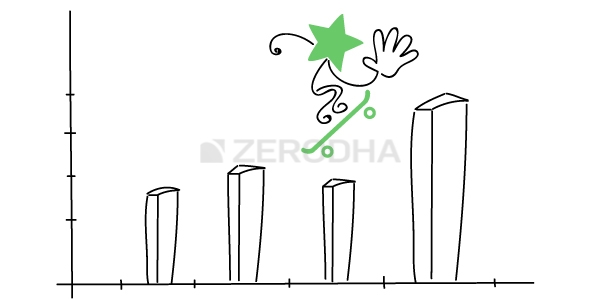11.1 – Corporate Actions
Corporate actions are financial initiatives undertaken by a company that results in a change to its stock price. There are different corporate actions that an entity can choose to initiate. A good understanding of these corporate actions gives a clear picture of the company’s financial health and determines whether to buy or sell a particular stock.
This chapter will examine the five most important corporate actions and their impact on stock prices. A corporate action is initiated by the board of directors and approved by the company’s shareholders.
 11.2 – Dividends
11.2 – Dividends
Dividends are portions of profits made by the company, which are distributed to the company’s shareholders. Dividends are paid on a per-share basis. For example, Infosys recently declared a dividend of Rs.42/- per share, which means you get Rs.42/- as dividend income for every share you own. Suppose you own 100 Infosys shares; you can get 100*42 = Rs.4,200/- as dividend income. The company directly remits the dividends to your bank account (linked to your Demat account). The dividend paid is also expressed as a percentage of the face value. In the above case, the face value of Infosys is Rs.5/-, and the dividend paid was Rs.42/- hence the dividend payout is said to be 840% (42/5).
It is not mandatory to pay dividends every year. If the company feels that instead of paying dividends to shareholders, they are better off utilizing the same cash to fund a new project for a better future, they can do so. Typically, companies in the growth phase (young companies growing fast) choose not to pay dividends but rather to plow back the profits into the business for more growth. However, when the company’s growth opportunities slow down and it holds excess cash, it would make sense to reward its shareholders via dividends. Cash with shareholders makes more sense than retaining the cash on the company’s book, and distributing the dividends may be the best way forward for the company.
The dividends need not be paid from the profits alone. If the company has made a loss during the year but it holds a healthy cash reserve, it can still pay dividends from its cash reserves.
The company’s board members at the Annual General Meeting (AGM) decide whether to pay a dividend. The dividends are not paid right after the announcement. This is because the shares are traded throughout the year, and it would be difficult to identify who is eligible to receive dividends and who isn’t. The following timeline would help you understand the dividend cycle.
Dividend Declaration Date: This is the date on which the AGM takes place, and the company’s board approves the dividend issue
Record Date: The date the company decides to review the shareholder’s register to list all eligible shareholders for the dividend. Usually, the time difference between the dividend declaration date and the record date is 30 days.
Ex-Date/Ex-Dividend date: With the T+1 settlement cycle, the ex-dividend date normally is on the same day as the record date. Only shareholders who own the shares before the ex-dividend date are entitled to receive the dividend. This is because, in India, the equity settlement is on a T+1 basis. So for all practical purposes, if you want to be entitled to receive a dividend, you need to ensure you buy the shares before the ex-dividend date.
Dividend Payout Date: The date on which the dividends are paid to shareholders listed in the company register.
Cum Dividend: The shares are said to be cum dividends till the ex-dividend date.
When the stock goes ex-dividend, usually, the stock drops to the extent of dividends paid. For example, if ITC (trading at Rs. 335) has declared a dividend of Rs.15. On ex-date, the stock price will drop to the extent of the dividend paid, and as in this case, the price of ITC will drop down to Rs.320. The reason for this price drop is that the dividend amount paid no longer sits on the company’s balance sheet; hence the stock price is adjusted. From the balance sheet perspective, dividends paid are considered cash out. Hence the new stock price has to factor in the shrunk balance sheet. Hence the price drops. That said, you will not always notice a significant price drop in the share price.
Sometimes, the company pays out a special dividend. A special dividend is non-recurring and happens on a ‘one-time basis.’ The special dividends are usually very large payments compared to a regular dividend, and that’s when the stock price significantly drops. The drop in stock price should not be considered negative as you would receive a cash payment as a shareholder.
Lastly, dividends can be paid anytime during the financial year. If it’s paid during the financial year, it is called the interim dividend. If the dividend is paid at the end of the financial year, it is called the final dividend.
 11.3 – Bonus Issue
11.3 – Bonus Issue
A bonus issue is a stock dividend allotted by the company to reward the shareholders. In regular dividends, cash is paid out to shareholders, but in a bonus issue, stocks are paid out instead of cash. The bonus shares are issued out of the reserves of the company. The shareholders receive these free shares against shares they currently hold. These allotments typically come in a fixed ratio of 1:1, 2:1, 3:1, etc. In a bonus issue, the stock price declines to the extent of the bonus ratio, but this decline should not be mistaken for a correction in stock price or a fall.
If the ratio is 2:1, the existing shareholders get two additional shares for every share they hold at no additional cost. So if a shareholder owns 100 shares, 200 additional shares will be rewarded. The total holding after the bonus issue will become 300 shares. When the bonus shares are issued, the number of shares the shareholder holds will increase, but an investment’s overall value will remain the same.
To illustrate this, let us assume a bonus issue on different ratios – 1:1, 3:1 and 5:1
| Bonus Issue | No. of shares held before bonus. | Share price before Bonus issue | Value of Investment | No. of shares post Bonus. | Share price after Bonus issue | Value of Investment |
|---|---|---|---|---|---|---|
| 1:1 | 100 | 75 | 7,500 | 200 | 37.5 | 7500 |
| 3:1 | 30 | 550 | 16,500 | 120 | 137.5 | 16,500 |
| 5:1 | 2000 | 15 | 30,000 | 12,000 | 2.5 | 30,000 |
So as you see, in a bonus issue, only the number of shares increases, and your investment value remains the same before and after the bonus issue.
The bonus announcement date, ex-bonus date, and record date are similar to the dividend issue.
Companies issue bonus shares to encourage retail participation, especially when the company’s price per share is very high, and it becomes tough for new investors to buy shares. The number of outstanding shares increases by issuing bonus shares, but the share price is slashed, as shown in the example above.
Think about this – fewer retail participants can buy or sell that share if the share price is bloated (I mean just the per-share price here, not the valuation). For example, the share price of MRF Limited is in the region of Rs.90,000 per share. A retail investor has to shell out 90K to buy and invest in 1 share, and this also means a small retail investor, with, say, Rs.25,000 to invest, can never buy MRF. Many retail investors spread the risk across 100s and 1000s of investors as opposed to a few investors. Hence, when the stock price bloats, companies issue a bonus share to slash the stock price without impacting any other financial metric, which is one reason to issue a bonus share.
Why isn’t MRF splitting the shares, then? Well, at the end of the day, the decision is solely dependent on the company and I guess MRF is yet to make up their mind or perhaps they just wont indulge in these corporate actions 🙂
 11.4 – Stock Split
11.4 – Stock Split
The word stock split sounds weird, but this happens regularly in the markets. What this means is quite literally – the stocks that you hold are split!
Similar to a bonus issue, when the company declares a stock split, the number of shares held increases, but the investment value remains the same. The big difference between a bonus and a split is that in the bonus issue, the face value of the company remains unchanged, but in a stock split, the face value changes. Suppose the stock’s face value is Rs.10, and there is a 1:2 stock split, then the face value will change to Rs.5. If you owned one share before the split, you would now own two shares after the split.
We will illustrate this with an example:
| Split Ratio | Old FV | No. of shares you own before split | Share Price before split | Investment Value before split | New FV | No. of shares you own after the split | Share Price after the split | Investment value after the split |
|---|---|---|---|---|---|---|---|---|
| 1:2 | 10 | 100 | 900 | 90,000 | 5 | 200 | 450 | 90,000 |
| 1:5 | 10 | 100 | 900 | 90,000 | 2 | 500 | 180 | 90,000 |
Like a bonus issue, a stock split encourages more retail participation by reducing the value per share. The dates and timeline (announcement date, ex-date, record date, etc.) are similar to dividend and bonus issues.
 11.5 – Rights Issue
11.5 – Rights Issue
The idea behind a rights issue is to raise fresh capital. However, instead of going public, the company approaches its existing shareholders. Think about the rights issue as a second IPO and a select group of people (existing shareholders). The rights issue could indicate promising new development in the company, but this is not always true. As an investor, you need to evaluate the reasons for the right issue and determine if it makes sense. The shareholders can subscribe to the rights issue in the proportion of their shareholding. For example, 1:4 rights issue means for every four shares; the shareholder can subscribe to 1 additional share. The new shares under the rights issue will be issued at a lower price than what prevails in the markets. For example, if a stock is trading at Rs.500 per share, then the right issue could be at a 20% discount, at Rs.400 per share.
However, a word of caution – The investor should not be swayed by the company’s discount, but they should look beyond that. A rights issue is different from a bonus issue as one is paying money to acquire shares. Hence the shareholder should subscribe only if he or she is completely convinced about the company’s future. It can so happen that after the company announces the right issue, the stock price can go below the right issue price. If the market price is below the subscription price/right issue price, it is cheaper to buy it from the open market.
 11.6 – Buyback of shares
11.6 – Buyback of shares
A buyback can be seen as a company’s method to invest in itself by buying shares from other investors in the market. Buybacks reduce the number of shares outstanding in the market; however, the buyback of shares is an important corporate restructuring method. There could be many reasons why corporates choose to buy back shares…
- Improve the profitability on a per-share basis
- To consolidate their stake in the company.
- To prevent other companies from taking over.
- To show the confidence of the promoters about their company.
- To support the share price from declining in the markets.
When a company announces a buyback, it signals the company’s confidence in itself. Hence this is usually positive for the share price, but like other things in the market, always evaluate the reasons for the corporate action.
Key takeaways from this chapter
- Corporate actions have an impact on stock prices.
- Dividends are a means of rewarding shareholders. The dividend is announced as a percentage of the face value.
- You must own the stock before the ex-dividend date to get the dividend.
- A bonus issue is a form of stock dividend. This is the company’s way of rewarding the shareholders with additional shares.
- A stock split is done based on the face value. The face value and the stock price change in proportion to the change in face value
- A rights issue is how the company raises fresh capital from the existing shareholders. Subscribe to it only if you think it makes sense
- Buyback signals a positive outlook for the promoters. This also conveys to the shareholders that the promoters are optimistic about the company’s prospects.




First of all many thanks for sharing knowledge in a format which everyone can understand.
I have a doubt on your below impact on stock price due to dividend payment –
“When the stock goes ex dividend, usually the stock drops to the extent of dividends paid. For example if ITC (trading at Rs. 335) has declared a dividend of Rs.5. On ex date the stock price will drop to the extent of dividend paid, and as in this case the price of ITC will drop down to Rs.330. The reason for this price drop is because the amount paid out no longer belongs to the company.”
If this is so easy then will it not create a shorting opportunity just before the ex-dividend date if the dividend amount is significant?
Thanks for your kind words.
With respect to shorting just before ex-dividend..its not so easy. Think about it, everybody attempts to do the same 🙂
Not clear. Please elaborate.
When dividends are expected, the stock tends to dip to the extent of the dividend paid. This is a known fact and there is no edge shorting based on this expectation.
This is not the correct explanation Karthik. When you are shorting a cum-dividend stock and squaring off when the stock goes ex-dividend, you need to square off with the ex-dividend stock plus the dividend amount. Since you have to pay the dividend amount as well to square off, there is no gain.
To sell short you first must set up a margin account with your broker. A margin account allows you borrow from your brokerage company using the value of your portfolio as collateral. The general rule is that the value of your portfolio must equal at least 50% of the size of the short sale transaction. In other words, If you have Rs. 100,000 worth of stock/cash in your margin account, you can borrow Rs. 200,000 of stock to sell short.
Prateek – are you talking about shorting in the spot or Futures market?
So what Prateek says, is it correct?
How to keep a track or get to know about these dates in specific?
You will have to follow the news, Rakesh.
dear sir its my humble request to you plz provide ( I P O ) facility in zerodha its self only this what we are missing for example i cant apply ipo from zerodha every time i need to go netbanking ..etc…
Narendra, this is the only way for now – https://support.zerodha.com/category/trading-and-markets/corporate-actions/articles/how-to-apply-for-ipos-and-how-to-stay-informed-of-new-ones
If someone bought shares of BEL yesterday (27th SEPT). will the shares be delivered with price adjusted for ex bonus. I mean deliveries for BEL yesterday were at 60% so all those who bought were already aware that tomorrow price will go down 10%.. so why they’d take such a risk ?
I’m thinking that during delivery of these shares the price should be adjusted to ex bonus.. or is it not ?
Thanks in advance for the info.
Cheers!
Its not really a risk as the prices are adjusted to the extent of bonus. SO there is no risk.
how much time required for bonus share credit in demat account. ?
Pradip, it can take upto 15 days to get credited to your DEMAT Account (depends on the RTA handling the company’s shares).
Check this article on the Support Portal for more
I have a question wit regards to dividend…I some where read on google DAT stock price will get reduced to the extent of percentage declared…ex:if 300 price stock company declared 40% of face value 10…den stock price will reduced to 40%..which is Rs.120 …is it true…plz provide some info…thanks in advance
No, 40% is calculated on the face value. So that would be 40%*10 = 4. Hence, the stock price may reduce to 300-4 = 296. However, you may not experience this for small dividend payouts. Happens when large dividends (special dividends) are paid out.
How can we call the Bonus Issue as a reward to shareholders when the value of investment is not increasing?
Thanks
With the Bonus issue the number of shares increases, this means when dividends are issued you earn more money 🙂
Does the Face Value remain the same on bonus issue?
Yes, it does.
Karthik. first of all thanks for the info sharing. Really fantastic initiative.
My question to your response for
So, what is the difference between Bonus issue and Stock Split? seems to be a very thin line.
1) The value of investment is not increasing in both cases.
2) The # of shares remains the same
So the difference is the change value remains same in Bonus issue and reduces in Stock split?
Bonus issue – you get additional shares against what you already hold. This is also considered as a dividend in the form of new shares issued. The split is dividing the shares. Both cases number of shares increases, value remains the same.
Hi,
Thanks for the great initiative by zerodha.
Its really helpful.
I have a doubt on these topics- bonus issue and stock split.
In both the cases the number of shares we are holding increases but the value remains the same?
Except the face value decreases by stock splits.
Are there any other differences between bonus issue and stock split.
Please explain.
Thanks.
Yes, the investment value remains the same. In stock split, the Face value reduces and in Bonus issue it does not. In both the cases. This helps in realizing a higher dividend value.
How does Stock Split and Bonus shares help us realize more dividend value.
According to my understanding,
Consider before Stock Split FV of a XYZ share is 10. Dividend announced would be 1000% ie Rs 100 per share. After Stock Split FV would be 5 and 2X shares. Dividend announced would be 1000% ie 5*2*10 = 100 for 2 shares. Dividend would not increase right.
In case of Bonus since FV does not decrease the Dividend realization increases right?.
That right. Maybe I need to rewrite this bit. But there is another angle here – capital appreciation, especially for companies with strong capital structure and business model. For example Relaxo Footware was trading around 800 in early 2014..the stock split and the value dropped to 175. The number of shares increased and the stock continued to rally…its back to 800 now, so in the whole process massive wealth has been created. This is one of the advantages of stock split.
Hi,
Here I am not able to understand 5*2*10. What is 10 in this case ?
Face value?
Hi Karthik,
Please mention this is the module, in case of stock split the face value also splits, while in case of bonus shares the face value remains the same. Otherwise both look exactly the same just the name difference.
And thanks I have been confused for a long time about these, only came to know from the comments.
Is that not mentioned already? If not, I will plug that in. Thanks for pointing, Tanmay.
“Only shareholders who own the shares before the ex dividend date are entitled to the dividend.”
If I bought the shares 4 days before the AGM and sell on AGM day, still I am entitled to get the dividend?
No Sir. In fact AGM is when the decision on any corporate actions (bonus, dividend, stock split etc) is taken. For you to enjoy the benefit, you need to be a shareholder by the record date.
So if I buy it before AGM and sell it after record date, am I eligible for dividend?
Yes Sir, you will be.
if I buy shares of company 3 days before record date, am I eligible for bonus issue?
Yes you will be eligible as long as you hold the company’s shares before the record date.
Sir, if I buy after AGM but before EX date , then will I get the benfit ?
Yes, you will.
How a 5:1 bonus will be issued, if a investor has 4 shares or 21 shares. Do the investor lose benefit for some shares in this case? If so, will that money be moved to share capital from surplus or not?.
A 5:1 bonus indicates 5 additional shares are being issued for every 1 shares. If the investor has 4 shares (before issue), he would get 20 additional shares, likewise if you held 21 shares.